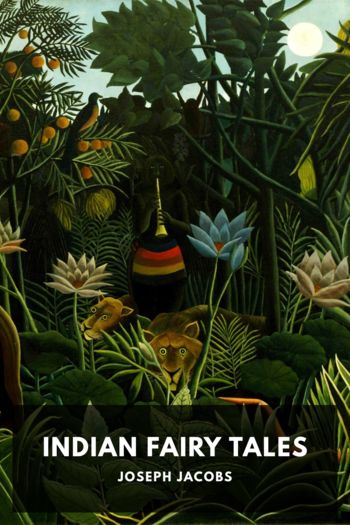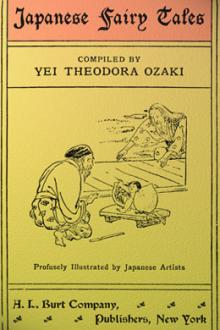Indian Fairy Tales by Joseph Jacobs (best books to read for students TXT) 📕

- Author: Joseph Jacobs
Book online «Indian Fairy Tales by Joseph Jacobs (best books to read for students TXT) 📕». Author Joseph Jacobs
Source.—The “Sīha Camma Jātaka,” Fausböll, No. 189, trans. Rhys-Davids, pp. V vi.
Parallels.—It also occurs in Somadeva, Katha Sarit Sagara, ed. Tawney, II 65, and n. For Aesopic parallels cf. my Aesop, Av. IV. It is in Babrius, ed. Gitlbaur, 218 (from Greek prose Aesop, ed. Halm, No. 323), and Avian, ed. Ellis, 5, whence it came into the modern Aesop.
Remarks.—Avian wrote towards the end of the third century, and put into Latin mainly those portions of Babrius which are unparalleled by Phaedrus. Consequently, as I have shown, he has a much larger proportion of Eastern elements than Phaedrus. There can be little doubt that the Ass in the Lion’s Skin is from India. As Prof. Rhys-Davids remarks, the Indian form gives a plausible motive for the masquerade which is wanting in the ordinary Aesopic version.
XXI The Farmer and the MoneylenderSource.—Steel-Temple, Wideawake Stories, pp. 215–8.
Parallels enumerated in my Aesop, Av. XVII. See also Jacques de Vitry, Exempla, ed. Crane, No. 196 (see notes, p. 212), and Bozon, Contes moralisés, No. 112. It occurs in Avian, ed. Ellis, No. 22. Mr. Kipling has a very similar tale in his Life’s Handicap.
Remarks.—Here we have collected in modern India what one cannot help thinking is the Indian original of a fable of Avian. The preceding number showed one of his fables existing among the Jatakas, probably before the Christian era. This makes it likely that we shall find an earlier Indian original of the fable of the Avaricious and Envious, perhaps among the Jatakas still untranslated.
XXII The Boy with Moon on ForeheadSource.—Miss Stokes’ Indian Fairy Tales, No. 20, pp. 119–137.
Parallels to heroes and heroines in European fairy tales, with stars on their foreheads, are given with some copiousness in Stokes, l. c., pp. 242–3. This is an essentially Indian trait; almost all Hindus have some tribal or caste mark on their bodies or faces. The choice of the hero disguised as a menial is also common property of Indian and European fairy tales: see Stokes, l. c., p. 231, and my List of Incidents (s. V “Menial Disguise.”)
XXIII The Prince and the FakirSource.—Kindly communicated by Mr. M. L. Dames from his unpublished collection of Baluchi tales.
Remarks.—Unholy fakirs are rather rare. See Temple, Analysis, I ii a, p. 394.
XXIV Why the Fish LaughedSource.—Knowles, Folktales of Kashmir, pp. 484–90.
Parallels.—The latter part is the formula of the Clever Lass who guesses riddles. She has been bibliographised by Prof. Child, English and Scotch Ballads, I 485; see also Benfey, Kl. Schr. II 156 seq. The sex test at the end is different from any of those enumerated by Prof. Köhler on Gonzenbach, Sezil. Mähr. II 216.
Remarks.—Here we have a further example of a whole formula, or series of incidents, common to most European collections, found in India, and in a quarter, too, where European influence is little likely to penetrate. Prof. Benfey, in an elaborate dissertation (“Die Kluge Dirne,” in Ausland, 1859, Nos. 20–25, now reprinted in Kl. Schr. II 156 seq.), has shown the wide spread of the theme both in early Indian literature (though probably there derived from the folk) and in modern European folk literature.
XXV The Demon with the Matted HairSource.—The “Pancāvudha-Jātaka,” Fausböll, No. 55, kindly translated for this book by Mr. W. H. D. Rouse, of Christ’s College, Cambridge. There is a brief abstract of the Jataka in Prof. Estlin Carpenter’s sermon, “Three Ways of Salvation,” 1884, p. 27, where my attention was first called to this Jataka.
Parallels.—Most readers of these Notes will remember the central episode of Mr. J. C. Harris’ Uncle Remus, in which Brer Fox, annoyed at Brer Rabbit’s depredations, fits up “a contrapshun, what he calls a Tar Baby.” Brer Rabbit, coming along that way, passes the time of day with Tar Baby, and, annoyed at its obstinate silence, hits it with right fist and with left, with left fist and with right, which successively stick to the “contrapshun,” till at last he butts with his head, and that sticks too, whereupon Brer Fox, who all this time had “lain low,” saunters out, and complains of Brer Rabbit that he is too stuck up. In the sequel Brer Rabbit begs Brer Fox that he may “drown me as deep ez you please, skin me, scratch out my eyeballs, t’ar out my years by the roots, en cut off my legs, but do don’t fling me in dat brier patch;” which, of course, Brer Fox does, only to be informed by the cunning Brer Rabbit that he had been “bred en bawn in a brier patch.” The story is a favourite one with the negroes: it occurs in Col. Jones’ Negro Myths of the Georgia Coast (Uncle Remus is from S. Carolina), also among those of Brazil (Romero, Contos do Brazil), and in the West Indian Islands (Mr. Lang, “At the Sign of the Ship,” Longman’s Magazine, Feb. 1889). We can trace it to Africa, where it occurs in Cape Colony (South African Folklore Journal, vol. I).
Remarks.—The fivefold attack on the Demon and the Tar Baby is so preposterously ludicrous that it cannot have been independently invented, and we must therefore assume that they are causally connected, and the existence of the variant in South Africa clinches the matter, and gives us a landing-stage between India and America. There can be little doubt that the Jataka of Prince Five Weapons came to Africa, possibly by Buddhist missionaries, spread among the negroes, and then took ship in the holds of slavers for the New World, where it is to be found in fuller form than any yet discovered in the home of its birth. I say Buddhist missionaries, because there is a certain





Comments (0)